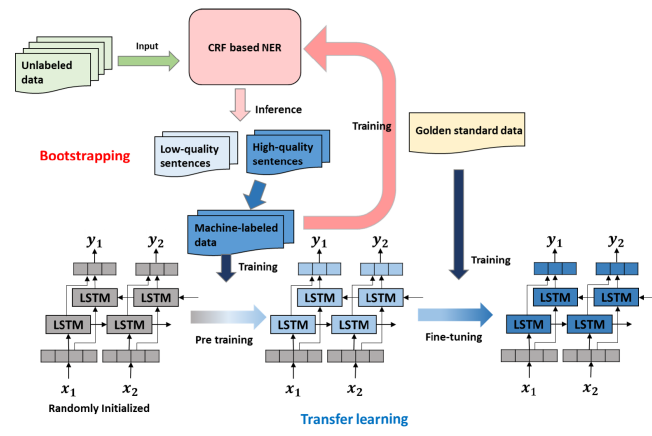Construction of Machine-Labeled Data for Improving Named Entity Recognition by Transfer Learning
Objective
In this paper, we propose a method for automatically generating training data and effectively using the generated data to reduce the labeling cost. The effect of our proposed method was verified with two versions of DNN-based named entity recognition (NER) models: bidirectional LSTM-CRF and vanilla BERT. Where the proposed NER systems outperform the baseline systems in both languages without the need for additional manual labeling.
Abstract
Deep neural networks (DNNs) require a large amount of manually labeled training data to make significant achievements. However, manual labeling is laborious and costly. In this study, we propose a method for automatically generating training data and effectively using the generated data to reduce the labeling cost. The generated data (called ‘‘machine-labeled data’’) is generated using a bagging-based bootstrapping approach. However, using the machine-labeled data does not guarantee high performance because of errors in the automatic labeling. In order to reduce the impact of mislabeling, we applied a transfer learning approach. The effect of our proposed method was verified with two versions of DNN-based named entity recognition (NER) models: bidirectional LSTM-CRF and vanilla BERT. We conducted NER tasks in two languages (English and Korean). The proposed method results in average F1 scores of 78.87% (3.9% point improvement) with bidirectional LSTM-CRF and 82.08% (1% point improvement) with BERT on three Korean NER datasets. In English, the performance increased by an average of 0.45% points with the two DNN-based models.
Keywords: Named Entity Recognition, Bootstrapping, Bagging, Transfer Learning, Deep Learning.
NOTE: Without the concern of our team, please don't submit to the college. This Abstract varies based on student requirements.
Block Diagram

Specifications
HARDWARE SPECIFICATIONS:
- Processor- I3/Intel Processor
- RAM- 4GB (min)
- Hard Disk- 128 GB
- Key Board-Standard Window
- Keyboard. Mouse-Two or Three Button Mouse.
- Monitor-Any.
SOFTWARE SPECIFICATIONS:
- Operating System: Windows 7+
- Technology: Python 3.6+
- IDE: PyCharm IDE
- Libraries Used: Pandas, NumPy, OpenCV, TensorFlow, Matplotlib.
Learning Outcomes
- Named entity recognition.
- Bootstrapping.
- Bagging.
- Transfer learning.
- Deep learning.
- Importance of PyCharm IDE.
- How ensemble models works.
- Process of debugging a code.
- The problem with imbalanced dataset.
- Benefits of SMOTE technique.
- Input and Output modules.
- How test the project based on user inputs and observe the output.
- Project Development Skills:
- Problem analyzing skills.
- Problem solving skills.
- Creativity and imaginary skills.
- Programming skills.
- Deployment.
- Testing skills.
- Debugging skills.
- Project presentation skills.
- Thesis writing skills.





 Paper Publishing
Paper Publishing
